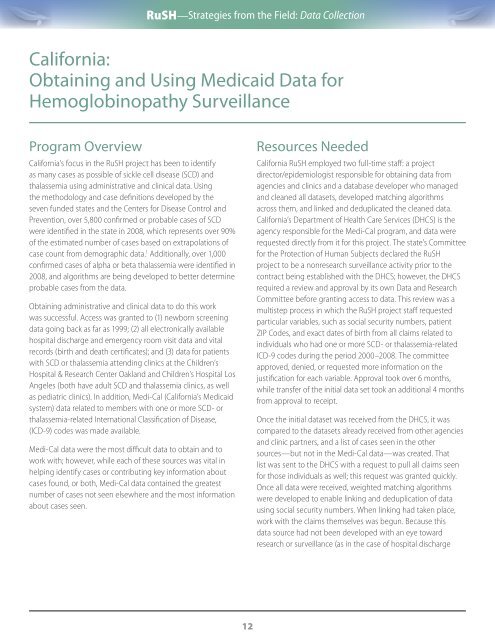RuSH: Strategies from the Field - Centers for Disease Control and ...
RuSH: Strategies from the Field - Centers for Disease Control and ...
RuSH: Strategies from the Field - Centers for Disease Control and ...
Create successful ePaper yourself
Turn your PDF publications into a flip-book with our unique Google optimized e-Paper software.
<strong>RuSH</strong>—<strong>Strategies</strong> <strong>from</strong> <strong>the</strong> <strong>Field</strong>: Data Collection<br />
Cali<strong>for</strong>nia:<br />
Obtaining <strong>and</strong> Using Medicaid Data <strong>for</strong><br />
Hemoglobinopathy Surveillance<br />
Program Overview<br />
Cali<strong>for</strong>nia’s focus in <strong>the</strong> <strong>RuSH</strong> project has been to identify<br />
as many cases as possible of sickle cell disease (SCD) <strong>and</strong><br />
thalassemia using administrative <strong>and</strong> clinical data. Using<br />
<strong>the</strong> methodology <strong>and</strong> case definitions developed by <strong>the</strong><br />
seven funded states <strong>and</strong> <strong>the</strong> <strong>Centers</strong> <strong>for</strong> <strong>Disease</strong> <strong>Control</strong> <strong>and</strong><br />
Prevention, over 5,800 confirmed or probable cases of SCD<br />
were identified in <strong>the</strong> state in 2008, which represents over 90%<br />
of <strong>the</strong> estimated number of cases based on extrapolations of<br />
case count <strong>from</strong> demographic data. 1 Additionally, over 1,000<br />
confirmed cases of alpha or beta thalassemia were identified in<br />
2008, <strong>and</strong> algorithms are being developed to better determine<br />
probable cases <strong>from</strong> <strong>the</strong> data.<br />
Obtaining administrative <strong>and</strong> clinical data to do this work<br />
was successful. Access was granted to (1) newborn screening<br />
data going back as far as 1999; (2) all electronically available<br />
hospital discharge <strong>and</strong> emergency room visit data <strong>and</strong> vital<br />
records (birth <strong>and</strong> death certificates); <strong>and</strong> (3) data <strong>for</strong> patients<br />
with SCD or thalassemia attending clinics at <strong>the</strong> Children’s<br />
Hospital & Research Center Oakl<strong>and</strong> <strong>and</strong> Children’s Hospital Los<br />
Angeles (both have adult SCD <strong>and</strong> thalassemia clinics, as well<br />
as pediatric clinics). In addition, Medi-Cal (Cali<strong>for</strong>nia’s Medicaid<br />
system) data related to members with one or more SCD- or<br />
thalassemia-related International Classification of <strong>Disease</strong>,<br />
(ICD-9) codes was made available.<br />
Medi-Cal data were <strong>the</strong> most difficult data to obtain <strong>and</strong> to<br />
work with; however, while each of <strong>the</strong>se sources was vital in<br />
helping identify cases or contributing key in<strong>for</strong>mation about<br />
cases found, or both, Medi-Cal data contained <strong>the</strong> greatest<br />
number of cases not seen elsewhere <strong>and</strong> <strong>the</strong> most in<strong>for</strong>mation<br />
about cases seen.<br />
12<br />
Resources Needed<br />
Cali<strong>for</strong>nia <strong>RuSH</strong> employed two full-time staff: a project<br />
director/epidemiologist responsible <strong>for</strong> obtaining data <strong>from</strong><br />
agencies <strong>and</strong> clinics <strong>and</strong> a database developer who managed<br />
<strong>and</strong> cleaned all datasets, developed matching algorithms<br />
across <strong>the</strong>m, <strong>and</strong> linked <strong>and</strong> deduplicated <strong>the</strong> cleaned data.<br />
Cali<strong>for</strong>nia’s Department of Health Care Services (DHCS) is <strong>the</strong><br />
agency responsible <strong>for</strong> <strong>the</strong> Medi-Cal program, <strong>and</strong> data were<br />
requested directly <strong>from</strong> it <strong>for</strong> this project. The state’s Committee<br />
<strong>for</strong> <strong>the</strong> Protection of Human Subjects declared <strong>the</strong> <strong>RuSH</strong><br />
project to be a nonresearch surveillance activity prior to <strong>the</strong><br />
contract being established with <strong>the</strong> DHCS; however, <strong>the</strong> DHCS<br />
required a review <strong>and</strong> approval by its own Data <strong>and</strong> Research<br />
Committee be<strong>for</strong>e granting access to data. This review was a<br />
multistep process in which <strong>the</strong> <strong>RuSH</strong> project staff requested<br />
particular variables, such as social security numbers, patient<br />
ZIP Codes, <strong>and</strong> exact dates of birth <strong>from</strong> all claims related to<br />
individuals who had one or more SCD- or thalassemia-related<br />
ICD-9 codes during <strong>the</strong> period 2000–2008. The committee<br />
approved, denied, or requested more in<strong>for</strong>mation on <strong>the</strong><br />
justification <strong>for</strong> each variable. Approval took over 6 months,<br />
while transfer of <strong>the</strong> initial data set took an additional 4 months<br />
<strong>from</strong> approval to receipt.<br />
Once <strong>the</strong> initial dataset was received <strong>from</strong> <strong>the</strong> DHCS, it was<br />
compared to <strong>the</strong> datasets already received <strong>from</strong> o<strong>the</strong>r agencies<br />
<strong>and</strong> clinic partners, <strong>and</strong> a list of cases seen in <strong>the</strong> o<strong>the</strong>r<br />
sources—but not in <strong>the</strong> Medi-Cal data—was created. That<br />
list was sent to <strong>the</strong> DHCS with a request to pull all claims seen<br />
<strong>for</strong> those individuals as well; this request was granted quickly.<br />
Once all data were received, weighted matching algorithms<br />
were developed to enable linking <strong>and</strong> deduplication of data<br />
using social security numbers. When linking had taken place,<br />
work with <strong>the</strong> claims <strong>the</strong>mselves was begun. Because this<br />
data source had not been developed with an eye toward<br />
research or surveillance (as in <strong>the</strong> case of hospital discharge

















